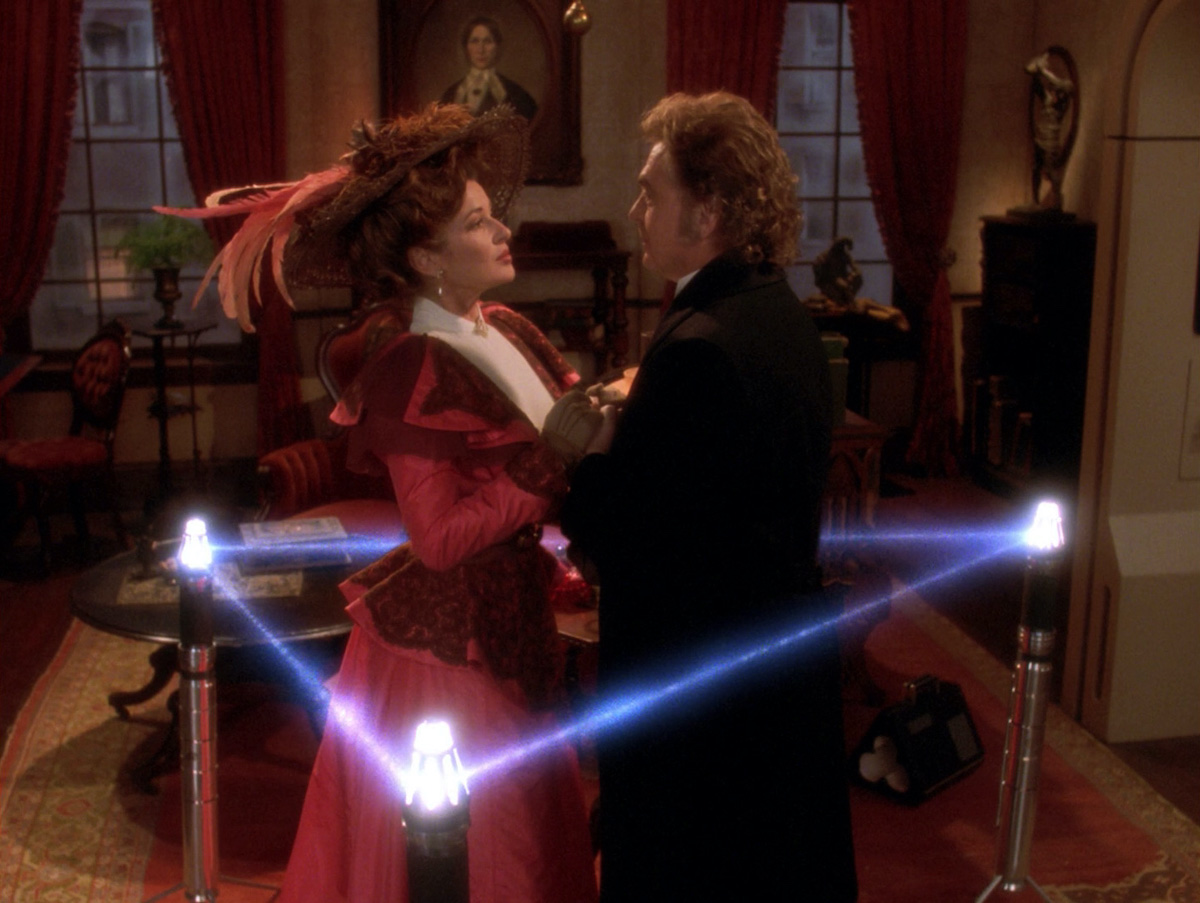“My past is nothing but a fiction.”
I didn’t have much use for this episode back in the day; it played into my various “meh” factors at the time like holodeck conceptual mysteries; weak use of Barclay; the Sherlock Holmes fantasy; and Data. I’ve come around on some of those, and I’ve nursed a suspicion that I might get more out of “Ship in a Bottle” this time around. But while it emerges as a rich episode from an idea standpoint, it takes a frustrating middle-of-the-road approach to its own gambit. There’s an opportunity for fireworks here, but they are left unlit.
There is always baseline stupidity in a case like this, because – even on the made-up science of a Star Trek episode – conceptual gymnastics of the type displayed here never fully solve. Is it credible that the Moriarty program, which caused so much trouble in “Elementary, Dear Data,” would be left as an unprotected file in active memory on the holodeck, for anyone to stumble over? Of course not. Is it credible that Barclay, recreational holodeck obsessivist and professional prime for holodecks among the engineers on the Enterprise, wouldn’t know about the Moriarty case? Nope. Is it credible that Data, unwittingly trapped in a holodeck simulation, would suddenly be unable to see the holodeck walls he could see quite clearly in “Encounter At Farpoint?” No sir. Is it credible to believe that if a holodeck character walked summarily off the holodeck, he would not only dematerialize, but – as evidenced by the concerns raised by characters in this episode, holographic and non-holographic alike – completely wipe his own program and cease to exist? That would be the equivalent of the Enterprise main computer having failed to perform routine Time Machine backups. But at least this explains, perhaps, what happened to Cyrus Redblock.
In terms of money left on the table, i.e. the “it would have been better if they did that” pile: there might have been something quite interesting in the idea of a Barclay/Moriarty buddy episode, the holodeck obsessivist and the manifest, sentient holodeck character. There’s also something quite alluring about the fact that Moriarty was semi-conscious over his 4-year imprisonment as a data file; imagine if the character had come out of the process as completely insane as you or I would be if we’d spent four years in a sensory deprivation tank, like the Joker released from Arkham. And in terms of gags not taken: it would have been hilarious if the teaser sequence ended with Barclay filing Moriarty away for another four years, before remembering to tell the Captain. Equally so, I’d have far preferred a final scene for this episode where Barclay’s “Computer, end program!” actually results in the program ending, revealing that the whole episode was just one of his holodeck games. Had that been the case, I might have slipped “Ship in a Bottle” more credit.
Well, like I said: at least this episode has ideas. It’s thick with them. They overlap. The story itself doesn’t follow nearly so many conceptual offshoots as it, itself, generates; it plays safe by only going one level into its “hologram within a hologram” scenario, and no further. As such there’s no real byplay on the question of what makes reality real, except as inference after the fact; and no attempt to go full-Inception by delving down any more “levels” of reality than necessary in what is, ultimately, a potential Matryoshka doll of a premise. This might be for the best: if holodecks can create holodecks within holodecks within holodecks, we are so totally, totally fucked.
The Picard morality question from “Elementary, Dear Data” is raised again – the ending of that episode was rewritten (at Gene Roddenberry’s request) so that the Captain would not lie outright to Moriarty to get him to relent to being stored as a file. Here, in spite of having at least attempted to keep his promise by passing the Moriarty problem on to Starfleet to solve, Picard goes ahead and lies to Moriarty anyway, gaining the closure the original episode lacked by way of Roddenberry’s recent death. Moriarty gets trapped in a self-sustaining holodeck memory chip, which he arguably had coming anyway. But here’s the rub, extending from Roddenberry’s original note: I can buy the fact that to solve the immediate problem, Picard had to deceive a holographic supercriminal. But why is everyone on the Enterprise suddenly so glibly unconcerned with the possibility that Moriarty is indeed, as Picard himself describes him, a new life form?
There are faint Frankenstein (and Bride of Frankenstein) echoes throughout, but the moral implications of Picard’s endgame are far darker than the all-smiles coda suggest. Having inadvertently created new life in a holographic machine that is, obviously by this point, far too dangerous for passive human use, Picard is now perfectly content to play God a second time, by deeming that Moriarty’s “life” is nothing more than a short-term problem that needs to be solved, and is perfectly well-served by entombing Moriarty eternally in a battery-powered version of the Matrix. All the dark joke needs, to come to full fruition, is a shot of Moriarty’s holographic box lying in the rubble of the Enterprise-D after the crash on Viridian III in Star Trek: Generations… and the “power” indicator starting to blink, and turn off.

Blogging The Next Generation runs every Tuesday as I work my way through the episodes of Star Trek: The Next Generation on blu-ray. Season Six is in stores. Season Seven will conclude the blog in early 2015 – you can pre-order the final season now.
